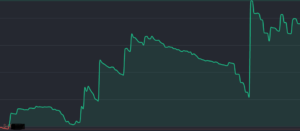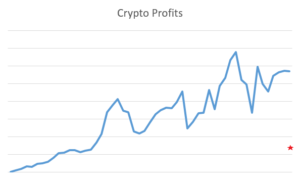Bales: What We Can Learn from My DFS and Crypto Profits
The other day, I posted a tweet that I believe best sums up my approach to investing/gambling—and a motto applicable to most life decisions that come with incomplete information (which is almost all of them):
It's not how often you're right that matters most, but how much you're rewarded when you're right (or when you're lucky)
— Jonathan Bales (@BalesFootball) February 26, 2018
I believe there’s less competition — and a bigger edge — in deciphering the “what you win” as opposed to the “how to win.” Or, put in another way that makes less sense and sounds confusing but I came up with it the other day in the shower and now secretly think it’s genius:
I’d rather be lucky, then good than good, then lucky.
There’s a greater reward in optimizing payoffs than optimizing the frequency of payoffs. I mostly try to approach problems with that mindset, which I believe is right but also leads to greater volatility. If you’re willingly trading in payoff frequency for larger payoffs (that are hopefully asymmetrical to the risk), you’re going to need to learn not only how to accept variance, but how to embrace and even harness it.
So with that said, I wanted to take a look at volatility in both the DFS and crypto spaces by showing my profits since January 1, 2017 — which I think could surprise some — and analyzing the similarities/differences between the two.
Bales: Bettors Are Already Equipped to Trade Crypto
Playing DFS can teach you how to embrace randomness, a skill you need in spades to be a profitable crypto investor.
DFS Profit
Below, I’ve posted my daily DFS profit/loss, via RotoTracker. Note that I’ve removed qualifiers because they aren’t tracked properly. (I know almost everyone loses money in Qs but I’ve run super hot in those and the profit increases if I add them, so there’s no sleight of hand here.) Also note that I’ve removed dollar amounts because it’s not really relevant to the discussion.

- This graph is characterized by a punctuated equilibrium in which I often lost a little (or sometimes a lot of) money, and occasionally made a lot of money.
- I was lucky to win a big tournament in the NFL playoffs early in the year, but the expectation is for sure not to be profitable most of the year (and, in fact, I am down in DFS this year thus far).
- If you remove a single week of NFL, I lost money in football this year (sort of … the results change if you add in the qualifiers).
- I’m good at the beginning of MLB. We know this. I suck by the end of MLB. We know this, too.
- Note to self: stop f—ing playing fantasy golf.
Crypto Profit
Let’s compare that graph — mostly small losses and infrequent large spikes — with my crypto graph over the same timeframe.

Note that this one is charted per week, as it’s actually quite difficult to track everything in a single place. Even using portfolio trackers, I need to make manual adjustments for certain exchanges that don’t have a proper history (or for other issues).
Also note that this is charted in USD profit. So if I invested $1 in total and had $2 worth of crypto assets, that would be tracked as $1 profit. If I invested $1 in crypto, withdrew $1 into fiat, and had $2 worth of crypto, that would be tracked as $2 profit. If I invested $1 in total, withdrew nothing, and had 50 cents in crypto, that would be a 50-cent loss. Like when Curtis Jackson went bankrupt.
- If we were to overlay the DFS graph on this one — something I could probably do but it would take a lot of time and I mean come on I haven’t even caught up on Vanderpump this week, are Stassi and Patrick gonna break up or what? — you’d see the DFS profits end up where I put that red star. That means I made more money in crypto than DFS this year, which was sort of hard not to do, but also that the swings in this graph (in an absolute sense) are far more drastic, particularly in the direction of “omfg what’s happening should I start eating more soup?”
- That’s to say, you can choose how much of your DFS bankroll you lose in a given day, but that’s not the case in crypto.
- I have far more “winning” weeks in crypto than in DFS, but, like I said, the downswings can be super sick.
- Note that this graph is correlated with crypto market cap, but doesn’t mirror it because there have been times when I’ve “loaded up” into more assets or converted a lot to cash. The drop at the end, for example, would be a lot steeper if I hadn’t converted about 70% of my portfolio into fiat before the “crash.” That’s not a commentary on my ability to trade cryptocurrency; it was mostly that I got so lucky on a certain exchange coin that went bonkers that my overall portfolio worth was too high a percentage of my net worth. I lost a large percentage of my portfolio during the crash just like everyone else, but the overall value of the portfolio at that time was much lower than in early January. A big part of being successful in crypto trading is just knowing when to hold mostly BTC/ETH, when to take chances on alts, and when to get the hell out. I’m a believer long-term, but to date, I’ve moved in and out of the market as a whole more so than most, for a variety of reasons I’ll discuss in another post.
Conclusions
The volatility is different in DFS and crypto. Playing GPPs, my expectation in any given night or week of DFS is to lose money. Jesus, that’s depressing. But for real, I lose money more often than I win money. That’s the case for every tournament player and, because winning money feels better than not winning money, people tend to create lineups such that they maximize their chances of cashing — which will not maximize long-term profits in contests with top-heavy payouts.
DFS is volatile and you can go on pretty long losing streaks (see the middle of my DFS graph when I was looking into raising squirrels for meat to get through the upcoming winter). However, losses are contained and build up gradually. I never have a sharp spike down, but there are lots of big jumps up.
Eventually, crypto trading will flatten out quite a bit more than what we see above, but for now, it’s a wild ride with big upside and downside. If you want exposure to frequent periods of immense growth — what amounts to a GPP win like every few days, basically — you have to also accept crazy swings in the opposite direction, too.
And those swings are mostly a matter of hype. I wrote about this when discussing a buy-low/sell-high strategy in 13 Tips for Investing in Crypto:
Yes, duh, you should always be looking to buy low and sell high. However, I’m of the opinion that it’s much, much tougher to recognize peaks and valleys in cryptocurrency since the market is so much different — and likely irrational — than something like the stock market. Given that so much of the value is speculative, short-term price fluctuations — especially for many altcoins — are more so a reflection of hype than underlying value.
As an example, let me tell you a little story about a coin called SAFEX. I bought a decent amount of it in early August. Why? I don’t even f—ing remember. It was probably awful reasoning.
A few days later, I went golfing with some friends. I shot 54 on a nine-hole Par 3 course, by the way, even though I used three balls and wrote down the best score on each hole. I’m no Kim Jong.
We started golfing at like 10 a.m. and by the time we finished at around noon, SAFEX had skyrocketed like 4x or something crazy. Why? No idea. Had I checked in halfway through that rise, I probably would have "sold high” and missed out on a lot of money.
This has happened in the opposite direction, too; when China banned ICOs, I bought a bunch of BTC after it had dropped quite a bit…only to see it decrease like 20% more.
Anyway, my point is that trying to time trades over small windows of time is very challenging. I’m all for buying and selling based on hype, but don’t get cocky in thinking you can identify highs and lows.
So DFS and crypto have different types and levels of volatility, but “solving” one is still useful in figuring out the other.
There are two ways in which this is true. The first is mathematically: understanding what you can risk, how much volatility you can tolerate, when you should take shots, how the nature of the swings should affect your strategy, and so on. The second — and perhaps more important — is emotionally: most people make huge errors in both DFS and crypto as a result of not being able to properly lose money. Guys, you’re gambling. That’s what it is. You might be +EV or you might have a negative expectation, but you’re gambling. You have to learn to be OK with losing money. The crypto market is arguably so inefficient at the moment that you can be profitable just not being an idiot with panic selling or buying at the peak of hype. Or it could just tank and everyone with exposure loses money.
One way to deal with the emotional hurdle if you aren’t accustomed to the swings is to rebalance. I actually am not really a fan of frequent rebalancing of your portfolio in crypto because I don’t think we really have enough confidence to say, “Well I know I should have 50% Bitcoin and not 30% or 80% or whatever.” And trading back and forth all the time costs money. Only when a specific asset goes nuts and I know I’m overexposed have I rebalanced or sold off just for the sake of it.
My buddy CSURAM88 had a really good argument for rebalancing, though, which was that it helps people naturally avoid emotional moves. If I commit to a 50/30/20 allocation, for example, and my top exposure declines in value such that it’s now 30% of my portfolio (and assuming I still feel the same way about it), then buying to get back to 50%—even if that number is “wrong” or sub-optimal—forces me to avoid emotional moves. So just committing to a strategy and rebalancing to get back to your desired allocation can be smart if it helps you avoid -EV emotional buying/selling.
That’s all for now. I’m going to leave you with a talk about the predictive value of Google search trends that has absolutely nothing to do with anything I’ve written here … but I liked it.
How would you rate this article?





